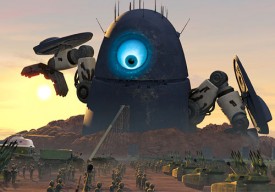
We’re monitoring the development of theatrical 3-D, which is supposed to revolutionize the cinematic experience as we know it. It’s currently being tested out in animated films like Monsters vs. Aliens and Coraline, and is soon to be unleashed in CGI/live-action feature form with James Cameron’s Avatar. Heavy bets are being placed by studio brass on this updated technology. Blustery PR bromides are circulating about how this will be the biggest tectonic plate shift since the Talkies. Special screens and digital projectors are being installed in cinemas internationally, though slower than planned because of the worldwide economic tailspin. Hey, it’s sorta like trying to launch sound cinema during the early days of the first Great Depression!
We really ought to time our cinematic revolutions better.
So how’s the 3-D revolution shaping up so far? Pretty damn well, actually, thanks for inquiring. I think we might be onto something here. Coraline’s fucking fabulous, and even Monsters vs. Aliens is riveting with the 3-D glasses on. (Note about the glasses: they’re way better than the old paper kind. Think of those big thick plastic black-framed nerd glasses that used to look cool on 1950s jazz stars and Civil Rights movement members. Dizzy Gillespie wore a pair.)
![]()
Of course I can’t say that combined CGI/live-action will be where it’s at in 3-D. Hard to envision, and Cameron’s refusing to leak any footage. But even if it’s just a revolution in animated film, that’s plenty to be going on with. It’s what we’ve been going on with for quite a while now, after all. Exciting talent’s been migrating out of live-action film for years, headed for animation and gaming and television and, I don’t know, biophysics, forestry, drug-running, anywhere else, as the evidence of the big screen attests. The American film industry’s recent motto should be, “Keep moving, folks, nothing to see here.”
It’s a testament to how much people want the theatrical experience of films to survive that we keep going to them as much as we do. Mediocre-to-atrocious retreads succeed at the box-office because there’s nothing else playing. Knowing is a hit.
So it’s sort of a surprise to me how grudgingly 3-D is being viewed by many film critics. Any port in a storm, you’d think; any excitement in Dullsville should be welcome. Of course, a lot of these critics are old enough to have been through the first 3-D craze in the 1950 and that makes them jaded. They complain about 3-Ds inevitable gimmickiness; they expect to see nothing but the occasional spear chucked at them from the screen. Roger Ebert demands to know why we can’t just watch regular old film without all this finicking technological wizardry:
I will say this first and get it out of the way: 3-D is a distraction and an annoyance. [Italics Ebert’s.] Younger moviegoers may think they like it because they’ve been told to, and picture quality is usually far from their minds. But for anyone who would just like to be left alone to see the darned thing, like me, it’s a constant nudge in the ribs saying never mind the story, just see how neat I look.
Of course, for those of us who like to see a film look “neat”—look better than “neat,” look stunning, look eye-slashingly great, make our eyes bleed with the splendor of it all!—well, let’s just say we’ve got different needs.
But it’s important to note, for the Roger Eberts among us, that you can still watch these films “flat” if you want. Or if you don’t happen to live near a 3-D equipped theater. Isn’t that inspiring, in and of itself, to say you have the option to watch a movie “flat”? The vocabulary alone is cool.
I notice this tendency among critics to oppose the look of the film to “the story,” as if any visual inventiveness necessarily takes away from “the story,” and “the story” is the holiest of holies and we must never stop concentrating on it or Tinkerbell dies and the terrorists win. It’s the number one rap against Monsters vs. Aliens, that somehow there’s too much spectacle and not enough story, and the characters aren’t sufficiently developed.
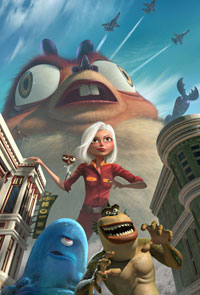
So here’s the story: a vapid girl from Central California (voice of Reese Witherspoon) is about to marry a dweeby weatherman (Paul Rudd) and lead a ghastly insipid life when she’s fortunately struck by a meteor and grows 45 feet, turning her into a “monster” who is then imprisoned in a military compound with other monsters such as a blob (Seth Rogan), a superstrong fish-man (Will Arnett), a supersmart bug–man (Hugh Laurie) and a giant screeching insect a la Mothra, all of whom you’ll recognize from ‘50s sci-fi films. Then the US is attacked by aliens, and the venal president (Stephen Colbert) is advised by a gung-ho general (Kiefer Sutherland) to release the monsters and let them fight the aliens, headed by squidlike egomaniac Galaxhar (Rainn Wilson), and you can guess the rest.
That’s PLENTY of story. That’s twice the recommended daily allowance of story.
As for character development, what else do I need to know about the vapid Central California girl who gets turned into an almost-50 foot woman? At first she wants to go back to her old life, then she realizes her new life is better. Even if I could know any more than that—like what? she’s overcome a childhood learning disability?—I don’t WANT to know any more than that. Jeez, people, every project ain’t Madame Bovary.

Monsters vs. Aliens is raucous and undemanding “flat” entertainment, no doubt, along the lines of other Dreamworks animated films like Shrek and Kung Fu Panda, loaded with pop culture references and easy gags and mild gross-outs for the kids, plus frequently gorgeous imagery. But the 3-D adds so much to it, I think we might be entering another golden age of “head films,” the old ‘60s-‘70s term for movies that are great to take drugs to/in/with. Walt Disney’s Fantasia was a popular favorite with the “head” crowd, but so was the entire Stan Brakhage oeuvre. Monsters vs. Aliens starts off with the same kind of state-of-the-art bid to be visually overwhelming: we’re in outer space, careening among the planets in 3-D; an alien spaceship passes through the rings of Saturn, sending space dust shooting out into our eyes.
This glorious dream-like intro is cut off with a typical 3-D sight gag, a bored guy playing with a paddle-ball that shoots out so far you think it’ll hit you smack in the nose. And between those two extremes, sublime to wacky, we move through such a range of 3-D effects that even Washington Post critic Ann Hornaday, who hated the film, has to admit it’s pretty hot stuff visually:
The movie, which company chief Jeffrey Katzenberg has been flogging as the flagship of his “3-D: It’s the Future!” campaign, does take technology to impressive new levels. With the exception of those early gags, and one or two menacingly outstretched arms, the film uses 3-D not for stunts but to create amazing visual depth and texture. Still, does anyone younger than 18 care about the subtleties of depth of field? (For that matter, does anyone over 18 care about it?)
Of course, Hornaday is smoking crack when it comes to that nobody-cares-about-depth-of-field howler. Whether they actually recognize the term or not, young people who are into media care more about depth of field now than anybody since 1950s French critic Andre Bazin said the deep-focus long-take shot was the essence of cinema and any remaining montage freaks out there could suck it.
A brief tutorial: deep-focus shooting is when everything in the frame from up close to far away is equally, sharply in–focus; shallow-focus is when the closer “plane” of people/objects is sharp but the background is blurred. Classical Hollywood films tended toward shallow-focus because it directs audience attention to what needs to be noted for the purposes of maximum clarity and comprehension as far as character, story, themes, etc. Deep-focus allows for greater compositional complexity and audience autonomy in choosing what to look at, when, and for how long, which is especially significant given the potential for multiple planes of simultaneous action and interest.
Since the term deep-focus refers to cameras and lenses, it isn’t completely applicable to computer-generated imagery, but the effect of deep-focus is more in play than ever. Gaming is all about deep-focus thrills. You’re plunged into a hyper-visible complex composition with multiple planes of action and have to navigate in, out, through while assailed by attackers from every direction. By composing a “deep space” that seems to contain the moving camera-eye, gaming has already established most of the 3-D moves that filmmakers are now racing to catch up with.
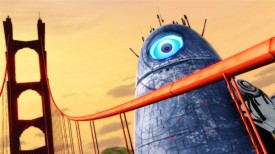
The challenge for old school filmmakers is to get out of the mindset and habits involved in composing the film frame, with its illusory depth of field seeming to extend out before us, and start composing for the encompassing 3-D “space,” with its greater illusory depth of field that seems to extend around and beside and behind us as well. Surround-sound can only do so much with the noises of incoming choppers over our heads and babies crying next to us and so forth.
This is an interesting problem that could very well goose the creative impulses of big-budget filmmakers for years to come. And they need it, bad. For every director who can actually keep in mind that even 2-D filmmaking can create an excellent illusion of a 3-D world extending all around the camera (see Steven Spielburg’s Jaws—he’ll never top it!), ninety-nine others never quite got the hang of it. So the rise of 3-D might force it upon them.
“Immersive” is the buzzword du jour describing the film experience that’ll drive the supposed revolution. But what we really need for full immersion is, of course, drugs. Where’s our soma? How can we have a Brave New World without soma?
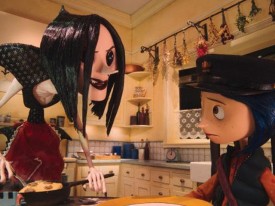
Important Addendum: if you haven’t seen Coraline in 3-D and you can still find it playing anywhere, go now. If you miss it, well, you missed it and you’ll have to watch it “flat.” It would take a hell of a sci-fi home entertainment system to give you the same effect. They’re trying to make us go to the theater, see?
In 3-D, Coraline’s one of those crazy little masterpieces that disorients you. In 2-D, I don’t know, it’ll still be a very nice eerie animated movie about a girl who discovers a secret passage from her family’s apartment into an alternate world containing the distorted mirror-image of her own home and family, only they’re fantastically improved, it seems. Until “Other Mother” asks to remove Coraline’s eyes and replace them with buttons so they can all be one big, button-eyed, nightmarishly smiling Other Family forever and ever. Good stuff, based on the Neil Gaiman book, but I bet it’s the 3-D that makes the film great.
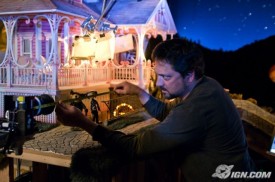
Coraline director Henry Selick (The Nightmare Before Christmas, James and the Giant Peach) must be deranged in the best possible way. He does claymation, which is already insane. (Move the clay figure one millimeter, shoot it; move it one more millimeter, shoot it; and so the long day wears on and by the end of it you’ve shot Coraline walking five steps.) But beyond that, designing for 3-D seems to have driven him into a wonderful, spacially obsessed fugue state in which you’d swear he’s theorizing at a very high level on the history of representing depth of field in various art forms for two hundred years. You’ve got your diorama effects, your 19th century theatrical trompe l’oeil backdrops, your pop-up books, your 1930s-‘40s Disney experiments in 3-D effects with the multiplane cameras, and so on, all evoked and alluded to throughout. Spaces in the house keep expanding and contracting, sinkholes open up, characters shape-shift, round orb-eyes are opposed to flat button-eyes, it’s so detailed it’s maniacal.
But eye-slashingly great!

Read more: 3-D, animation, Avatar, Coraline, gaming, James Cameron, Monsters vs. Aliens, Neil Gaiman, Eileen Jones, movies


Got something to say to us? Then send us a letter.
Want us to stick around? Donate to The eXiled.
Twitter twerps can follow us at twitter.com/exiledonline







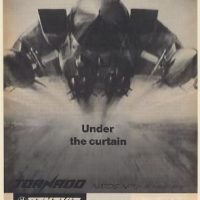


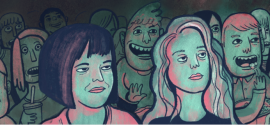

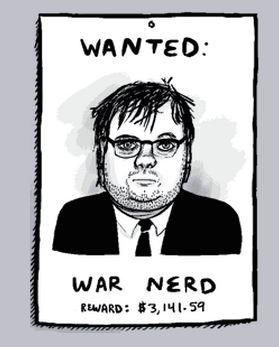


12 Comments
Add your own1. John Christy | March 29th, 2009 at 2:47 pm
Very interesting stuff
2. Harold | March 29th, 2009 at 4:14 pm
Since every good film movement needs a better manifesto-
“WE sing of earthquakes, we compose film epics of electric power plants and flame, we delight in the movements of comets and meteors and the gestures of searchlights that dazzle the stars.” Vertov
What will the epitaph of 3-D movies be?
“We tried?”
3. mechagodzilla | March 29th, 2009 at 8:23 pm
man, it sucks not being in the country for this one, I guess. Cheap gas prices, banker reality checks, 3-d movies…damn…
4. Lobo One | March 30th, 2009 at 1:48 am
Where’s the 3D adaptation of House of Leaves?
5. 7CedarsCasino | March 30th, 2009 at 7:16 am
I really want to watch it. Looks amazing.
6. Morgan | March 31st, 2009 at 12:21 am
We’re on the cusp of something we know not what. Thanks for leaving the door open without moralism or cynicism.
7. BoomTownCasinoBiloxi | March 31st, 2009 at 7:01 am
Those movies looks so cool. But yesterday I was reading about, people paying 10-20 bugs to see that movie!!!… This is true?
8. BorgataHotelAndCasino | March 31st, 2009 at 8:06 am
It can’t be… why so much???
9. John | April 1st, 2009 at 12:25 pm
“Good stuff, based on the Neil Gaiman book, but I bet it’s the 3-D that makes the film great.”
OK you are right, but the Neil Gaiman book
is incredibly multi-dimensional to begin
with. Interestingly, I just read it two
weeks ago for the first time, and I have
to say that I can hardly think of a better
basis for 3D animation.
10. Last | April 11th, 2009 at 6:26 am
Since your eyes are only maybe 3 inches apart you have no stereopsis beyond 20 feet or so – for stereo vision the world may as well be painted on a flat background that far away. However, our brains use a whole bag of tricks to determine the 3D structure of a scene outside the “it’s going to whack me in the face” range. One of these is to take advantage of the eye’s limited DoF to get a hint about what lies close to the focal plane. Video with excessive DoF (or unusual bokeh) messes with that trick and hence produces a subtle sense of unreality… after all, what you are watching really is just on a flat background 20-or-so feet away.
This can, of course, be used for good or evil.
11. The Amazing Crustacean | April 18th, 2009 at 9:12 pm
Eh, it isn’t a real movement until there’s porn of it. Without 3-d pussy it’s just a fad, no insult intended. Deep close ups of spread vaginas on the big screen is what I want, and I want it soon.
12. H. Purrbuckets | May 5th, 2009 at 10:59 am
I am in love with you Eileen. How can I get your attention? By critiquing you, or by stalking you? I am a loveworm.
Leave a Comment
(Open to all. Comments can and will be censored at whim and without warning.)
Subscribe to the comments via RSS Feed